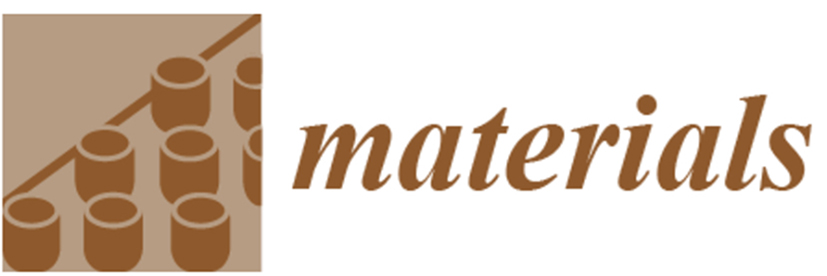ISSN (online): 1996-1944
Call of the Journal:
- Advanced Carbon Materials in Water Treatment or Separations Technology
- Advanced Functional Hybrid Materials for Novel Biomolecular Electronics
- Advances in Biomaterials | Design, Synthesis, Characterisation and Biomedical Application
- Advances in Construction and Building Materials
- Advances in Green Construction Materials
- Assessment of Metallurgical and Mechanical Properties of Welded Joints via Numerical Simulation and Experiments
- Carbon Compounds-Reinforced Ceramics
- Concrete and Waterproofing Materials | Development of Waterproofing Technology for Buildings and Civil Concrete Structures
- Corrosion Inhibitors for Steel | Experimental and Theoretical Studies
- Damage and Failure of Polymers, Polymer-Like Materials, Adhesives and Polymer Nanocomposites
- Development of Energy Storage or Conversion Element Based on Various Nano Materials
- Dyes | Synthesis, Properties, and Applications
- Dynamic Behavior of Ceramic Composites
- Flexible Sensors and Actuators for Novel Wearable Solutions
- Fundamentals and Applications of Bionano Sensor Techniques
- Graphene Foam Based Composites
- Growth and Application of Foam-Based Materials
- High Performance Concrete
- Hybrid Noble Metal/Graphene Aerogels | Synthesis, Characterization and Applications for Chemical Sensing and Biosensing
- Hydrogen Storage and Fuel Cells | Materials, Characterization and Applications
- Load Test and Numerical Analysis on Construction Materials
- Machining and Surface Properties of Steel Parts
- Materials under Extreme Conditions | Technologies for CRMs Reduction, Substitution and Recovery
- Microplastics and Nanoplastics | From Resource to Pollution
- Mineral-Bonded Composites for Enhanced Structural Impact Safety
- Modification and Processing of Biodegradable Polymers
- Nanostructured Semiconductors for Photoinduced Applications
- Novel Inorganic Adsorbents for Environmental Purification
- Numerical Simulation and Experimental Studies of Wave Phenomena in Composite Materials
- Performance Research of Polyurethane Foams and Composites
- Physics, Electrical and Structural Properties of Dielectric Layers
- Precision and Ultra-Precision Subtractive and Additive Manufacturing Processes of Alloys and Steels
- Processing and Thermal Properties of Hybrid Composites
- Recent Advances in 3D Printing for Biomaterials
- Recent Progress in the Development, Material Properties, and Post-Processing of Additively Manufactured Components
- Silica and Silica-based Materials for Biotechnology, Polymer Composites and Environmental Protection
- Study on the Modification and Compressive Properties of Concrete Buildings Materials
- Superconductors for Opto-Nano and Micro-Electro-Mechanical Systems (O-N/MEMS)
- Synthesis and Characterization of Hybrid Nanomaterials and Nanocomposites
- Synthesis, Properties and Applications of Polymer Blends
- Testing of Materials and Elements in Civil Engineering
- The Science and Technology of 3D Printing
Jan
2021
Feb
2021
Water purification technology benefits from the development and discovery of advanced materials. Importantly, various forms of carbon have been applied for advanced treatment techniques, for example, as highly effective adsorbents or electrodes. However, more recently, many other forms of carbon have been incorporated in water treatment technology, especially polymer membranes. For example, graphene and its various forms (carbon nanotubes, graphene oxide, and reduced graphene oxide) have been incorporated into composites or as coatings to achieve advanced materials in water treatment. For example, these materials can be used for advanced separations of solutes from solvents or to impart useful or unique properties to porous or dense membrane surfaces. The main focus of the forthcoming Special Issue is thus to present various examples of how advanced carbon materials can be applied in water treatment in order to give the reader an overview of the state of the art. The topics covered in the Special Issue include various advanced carbon materials applied to water treatment or separations technology.
Keywords: water treatment; carbon; graphene; carbon nanotubes; graphene oxide; membranes; adsorbents.
Advanced Carbon Materials in Water Treatment or Separations Technology
Water purification technology benefits from the development and discovery of advanced materials. Importantly, various forms of carbon have been applied for advanced treatment techniques, for example, as highly effective adsorbents or electrodes. However, more recently, many other forms of carbon have been incorporated in water treatment technology, especially polymer membranes. For example, graphene and its various forms (carbon nanotubes, graphene oxide, and reduced graphene oxide) have been incorporated into composites or as coatings to achieve advanced materials in water treatment. For example, these materials can be used for advanced separations of solutes from solvents or to impart useful or unique properties to porous or dense membrane surfaces. The main focus of the forthcoming Special Issue is thus to present various examples of how advanced carbon materials can be applied in water treatment in order to give the reader an overview of the state of the art. The topics covered in the Special Issue include various advanced carbon materials applied to water treatment or separations technology.
Keywords: water treatment; carbon; graphene; carbon nanotubes; graphene oxide; membranes; adsorbents.
ADS-Astrophysics Data System, AGORA(FAO), CAB Abstracts(CABI), Chemical Abstracts (ACS), Current Contents-Engineering, Computing & Technology (Clarivate Analytics), DOAJ, Ei Compendex/Engineering Village (Elsevier), Genamics JournalSeek, Global Health (CABI), HINARI (WHO), Inspec (IET), Journal Citation Reports/Science Edition (Clarivate Analytics), Julkaisufoorumi Publication Forum (Federation of Finnish Learned Societies), Norwegian Register for Scientific Journals, Series and Publishers (NSD), Polymer Library (Smithers Rapra), PubMed (NLM), Science Citation Index Expanded – Web of Science (Clarivate Analytics), Scopus (Elsevier), Web of Science (Clarivate Analytics), Zetoc (British Library), CLOCKSS (Digital Archive), e-Helvetica (Swiss National Library Digital Archive), PubMed Central (NLM), Academic OneFile (Gale/Cengage Learning), EBSCOhost (EBSCO Publishing), Energy & Power Source (EBSCO), Engineering Source (EBSCO), Google Scholar, J-Gate (Informatics India), Materials Science & Engineering (ProQuest).
Info at: www.mdpi.com/journal/materials/apc
Guest Editor
Dr. Christopher J. Arnusch









